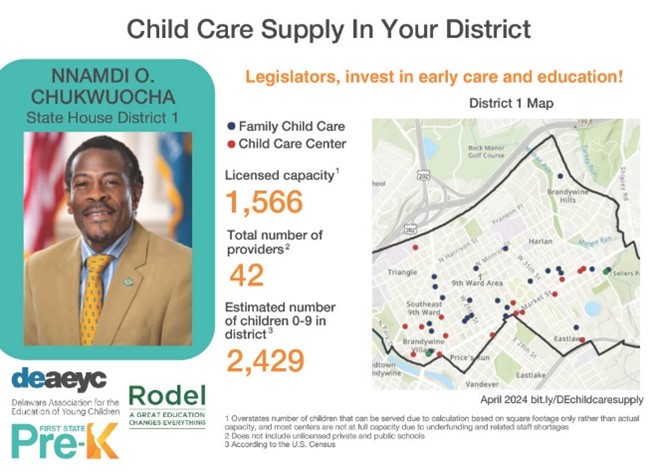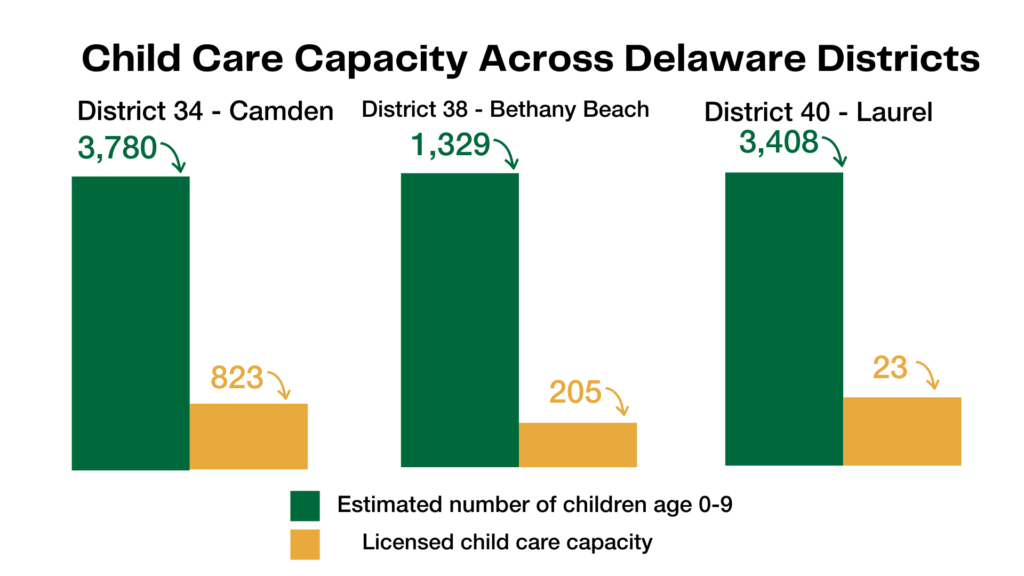Two Children for Every Available Seat: Delaware’s Unmet Child Care Demand
-A new mapping dashboard, updated in real time, visualizes Delaware child care supply by legislative district.
-Across the state, demand far outpaces supply, resulting in tens of thousands of children without access to care.
-In districts with the greatest gaps, there are ratios of seven children to one seat.

Affordable, accessible child care is a foundational necessity for supporting families and the economy.
But statewide data has showed us that as many as 80 percent of Delaware parents and caregivers are holding back from advancing their careers, pursuing education, or buying a home because they cannot access or afford child care. What does this look like at the local level?
A new analysis of child care facilities in Delaware organized by legislative district focuses on the supply and demand imbalance families face. Rodel and partners created a mapping dashboard in partnership with Child Care Aware that is updated in real time and visualizes child care supply by legislative district, includes filters for operational status, type of care, and more.
Part of Delaware’s state budget directly supports child care programming. Advocates and providers continue to push for increased investments so centers can hire and retain staff—the key ingredient needed to support more families.
During Early Childhood Advocacy Day earlier this spring, parents, caregivers, and providers brought this information to their representatives and senators at Legislative Hall using personalized dossiers. It was the first time that many legislators were able to see what the gaps are in their own districts. Here is just some of what we learned.

Demand Far Outpaces Statewide Supply
The total licensed capacity across Delaware—the number of children providers have space for—is 53,640. This falls short of the estimated number of children aged zero to nine in Delaware, 109,075, resulting in tens of thousands of children without access to care. These numbers highlight a significant gap in the availability of child care across the state.
When examining availability by county, there are 554 providers in New Castle County, 169 providers in Kent County, and 197 providers in Sussex County.* Three districts stood out as having the lowest number of providers in the state. These include districts in/around Seaford (HD 39) with just six providers, Millsboro (HD 4) with seven providers, and Newark (HD 23) with 10 providers.
The disparity in provider distribution, especially the high concentration in New Castle County, reinforces what we have heard from families: it is nearly impossible to find providers in the southern part of the state. However, these data also emphasize the widespread nature of the child care crisis, which affects all three counties, since the districts with the fewest providers are located in both the northern and southern parts of the state.
(* – Refers to licensed providers only. Public and private schools, which also offer child care and preschool, are not all licensed.)
2x-3x More Children than Seats: Child Care Deserts by District
It will not come as a surprise to longtime advocates that 59 districts out of 62 do not have an adequate child care supply, leaving only three districts with an adequate supply. The districts with the largest gaps are in/around Camden-Wyoming (HD 34), Dover (HD 32), Laurel (HD 40), Middletown (HD 9), and Felton (HD 30), who all have a population of children aged zero to nine in their districts that exceed licensed capacity by 2,000-3,000 seats.
A child care desert is defined as an area where child care supply does not meet the demand, according to Child Care Aware. These deserts are particularly prevalent in low-income communities, rural areas, and among families with irregular work schedules. By this definition, most districts in Delaware are child care deserts (keeping in mind not all families utilize a child care center within their district.)
In districts with the greatest gaps, there are ratios of seven children to one seat. In New Castle County, the average is two children to every one seat, and in Kent and Sussex counties, it is three children to every one seat.
Caveats and Considerations
What is even more alarming is these data likely underestimate the gap between the child care supply and demand. The “licensed capacity” approach likely overstates the number of children served (since the calculation is based on the square footage of each center, and despite the fact that most centers are not operating at full capacity). This, combined with other access issues for families including the age of children, time of year, and cost of care, means that these estimates are conservative to say the least.
We also know that child care needs extend up to age 12, not nine, and there are seasonal and scheduling challenges like summer care and misaligned schedules that leave parents and caregivers struggling to take advantage of school-aged care throughout the school year. On the other hand, we also recognize that not all families need or want formal child care, which means that this analysis is not perfect. It is, however, to our knowledge, the first attempt at quantify the gap between child care supply and demand for each legislative district in Delaware, providing decision-makers with insights into how child care shortages are affecting families in their districts. We know from recent surveys of parents that many more want child care than can access it.
What to Do Now?
Families, providers, business leaders and advocates continue to call on state policymakers and stakeholders to address the child care crisis.
Concerned Delawareans are invited to contact their local representatives or candidates for public office. Even better: Consider meeting with your local legislator in person. Visit and fill out this form to learn more about events in your area.
Related Topics: child care delaware, child care licensing, Delaware education, delaware elections, Delaware legislature, early learning, pre-k

